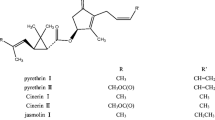Abstract
The origin and fate of the gin waste residues of three chemicals—toxaphene, DEF, and paraquat—used frequently in cotton production in California were studied. Residues were determined for foliage and bolls in the live plants, for lint and seed in harvested seed cotton, and for gin waste and its lint and non-lint components, following commercial treatments to the cotton crop. Gin waste residues were followed during five months of open storage to ascertain dissipation rates in a typical waste sample. Relatively high residues of each of the three chemicals persisted at harvest, during storage prior to ginning, and in stored gin waste. The major proportion of gin waste residue was associated with the non-lint components—leaf parts, burrs, stems and other foreign matter. Average stored gin waste residues in the lint and non-lint components were 13 and 60, 11 and 58, and 5 and 10 ppm for toxaphene, DEF, and paraquat, respectively, during the open storage period.
Similar content being viewed by others
References
Anderson, J. M., W. A. Pund, J. D. Cain, R. W. Rogers, and H. W. Essig: Feeding gin trash to beef cattle. Miss. Agr. Forest. Expt. Sta.,36(6), June (1973).
Anonymous: Pelleting—An answer to gin waste disposal? Progressive Farmer, p. 22 Aug. (1974).
Anonymous: Statutes of 1975 Recodification of California Air Pollution Control Laws. California Air Resources Board, Sacramento, Calif. Chapter 957 (1975).
Archer, T. E.: Toxaphene residues on alfalfa hay exposed to drying by sunlight, ultraviolet light, and air. J. Dairy Sci.54, 1180 (1971).
Griffin, Jr., A. C.: Fuel value and ash content of ginning wastes. Trans. Am. Soc. Agric. Engrs. 1 (1976).
Lalor, W. F., J. K. Jones, and G. A. Slater: Cotton gin trash as a ruminant feed. Agro-Industrial Report 2∶8(WU-1), Cotton Incorporated, Raleigh, N.C. (1975a).
—: Performance tests of heat recovery gin wastes incinerator. Agro-Industrial Report, Cotton Incorporated Raleigh, N.C. (1975b).
MacDougall, D.: DEF, In G. Zweig (ed.): Analytical Methods for Pesticides, Plant Growth Regulators, and Food Additives, Vol. 4, New York: Academic Press (1964).
McCutcheon, O. D.: Gin trash disposal. Report from Farm Advisors Office, Kings County, Calif. April (1975).
Miller, C. S., W. L. Hoover, and J. D. Price: Pesticide residues in cotton gin wastes. Texas Agr. Expt. Sta. Report MP-1184, April (1975).
Parr, J. F., and S. Smith: Degradation of toxaphene in selected anaerobic soil environments. Soil Science121, 52 (1976).
Stent, P.: The value of cotton gin trash as a livestock feed. Report prepared by Stanford Research Institute for Cotton Incorporated, Project 3413, Raleigh, N.C. July (1974).
Swoboda, A. R., G. W. Thomas, F. B. Cady, R. W. Baird, and W. G. Knisel: Distribution of DDT and toxaphene in Houston black clay on three watersheds. Environ. Sci. Technol.5, 141 (1971).
Winterlin, W. L., J. B. Rivers, and G. O. Walker: A simple improved all-glass system for the microanalysis of pesticides on the Dohrmann Model 100 GC. Bull. Environ. Contamin. Toxicol.2, 47 (1967).
Author information
Authors and Affiliations
Rights and permissions
About this article
Cite this article
Seiber, J.N., Winterlin, W.L. & McChesney, M.M. Residues of toxaphene, DEF, and paraquat in plant parts and gin waste from a treated cotton field. Arch. Environ. Contam. Toxicol. 8, 125–137 (1979). https://doi.org/10.1007/BF01056319
Received:
Accepted:
Issue Date:
DOI: https://doi.org/10.1007/BF01056319




